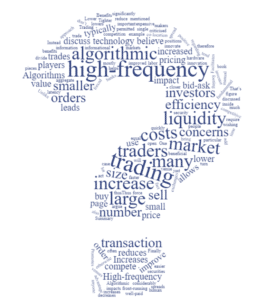Benefits of High-frequency Trading
High-frequency trading is often criticised because many investors believe they do not add value. Instead, many argue that high-frequency trading is front-running other investors. On this page, we discuss benefits of high-frequency trading. In particular, we discuss the positive impact on financial markets the market that algorithmic and high-frequency trading have.
At the same time, there are a number of concerns regarding algorithmic and high-frequency trading. We discuss these concerns on the page on disadvantages of high-frequency trading.
Facilitates large trades
A very important advantage of algorithmic trading is that it helps investors to sell large positions. Algorithmic trading typically allows an investor to divide an order into small pieces. These small trades will have a much smaller impact on the price than a single large trade. This reduces transaction costs and market impact considerably.
This approach also decreases the size of orders and increase the size of the number of orders. This leads to increased liquidity.
Increases liquidity
As we just mentioned, algorithmic trading increases liquidity. That’s because they increase the number of buy and sell orders and therefore increase the size of the order book significantly.
Lower costs
Algorithms don’t require human traders who are typically well-paid and thus expensive. Algorithms lower manual labor which in turn lowers transaction costs.
Tighter bid-ask spreads
Because high-frequency traders act as market makers, they tend to reduce the bid-ask spread. This reduces transaction costs for anyone wishing to buy or sell a particular security.
Improved pricing efficiency
Because high-frequency traders quickly aggregate a lot of information, they improve the informational efficiency of the market. They force the price closer to the fundamental value faster than would otherwise be the case. Thus, they increase pricing efficiency.
Promotes open and competitive markets
The use of technology allows smaller players to compete with the large banks. In fact, it is easier for smaller players to compete on an equal footing.
Increases competition between trading venues
Finally, securities exchanges are forced to innovate and to improve the trading technology they use. This leads to more innovation, a lower latency, and increased liquidity. One example is co-location, where traders are permitted to bring their own hardware inside the trading venue.
Summary
We discussed the benefits of high-frequency trading. Unlike what many people believe, high-frequency trading has been mostly beneficial.
